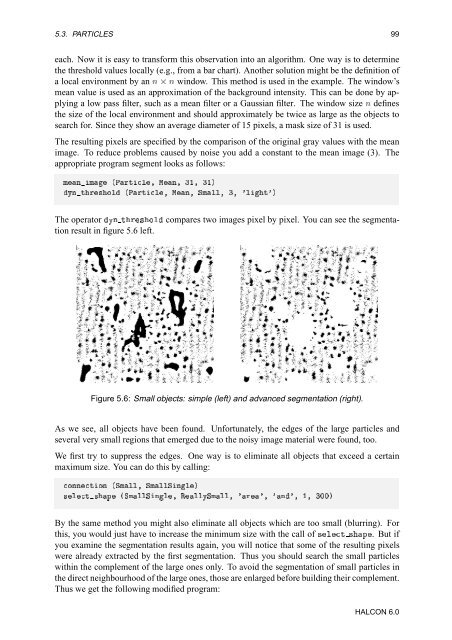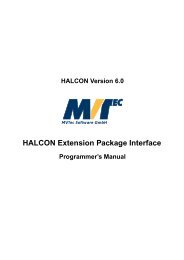You also want an ePaper? Increase the reach of your titles
YUMPU automatically turns print PDFs into web optimized ePapers that Google loves.
5.3. PARTICLES 99<br />
each. Now it is easy to transform this observation into an algorithm. One way is to determine<br />
the threshold values locally (e.g., from a bar chart). Another solution might be the definition of<br />
a local environment by an Ò ¢ Ò window. This method is used in the example. The window’s<br />
mean value is used as an approximation of the background intensity. This can be done by applying<br />
a low pass filter, such as a mean filter or a Gaussian filter. The window size Ò defines<br />
the size of the local environment and should approximately be twice as large as the objects to<br />
search for. Since they show an average diameter of 15 pixels, a mask size of 31 is used.<br />
The resulting pixels are specified by the comparison of the original gray values with the mean<br />
image. To reduce problems caused by noise you add a constant to the mean image (3). The<br />
appropriate program segment looks as follows:<br />
ÑÒÑ ´ÈÖØи ÅÒ¸ ¿½¸ ¿½µ<br />
ÝÒØÖ×ÓÐ ´ÈÖØи ÅÒ¸ ËÑÐи ¿¸ ³Ðسµ<br />
The operator ÝÒ ØÖ×ÓÐ compares two images pixel by pixel. You can see the segmentation<br />
result in figure 5.6 left.<br />
Figure 5.6: Small objects: simple (left) and advanced segmentation (right).<br />
As we see, all objects have been found. Unfortunately, the edges of the large particles and<br />
several very small regions that emerged due to the noisy image material were found, too.<br />
We first try to suppress the edges. One way is to eliminate all objects that exceed a certain<br />
maximum size. You can do this by calling:<br />
ÓÒÒØÓÒ ´ËÑÐи ËÑÐÐËÒе<br />
×ÐØ×Ô ´ËÑÐÐËÒи ÊÐÐÝËÑÐи ³Ö³¸ ³Ò³¸ ½¸ ¿¼¼µ<br />
By the same method you might also eliminate all objects which are too small (blurring). For<br />
this, you would just have to increase the minimum size with the call of ×ÐØ ×Ô. Butif<br />
you examine the segmentation results again, you will notice that some of the resulting pixels<br />
were already extracted by the first segmentation. Thus you should search the small particles<br />
within the complement of the large ones only. To avoid the segmentation of small particles in<br />
the direct neighbourhood of the large ones, those are enlarged before building their complement.<br />
Thus we get the following modified program:<br />
HALCON 6.0
















